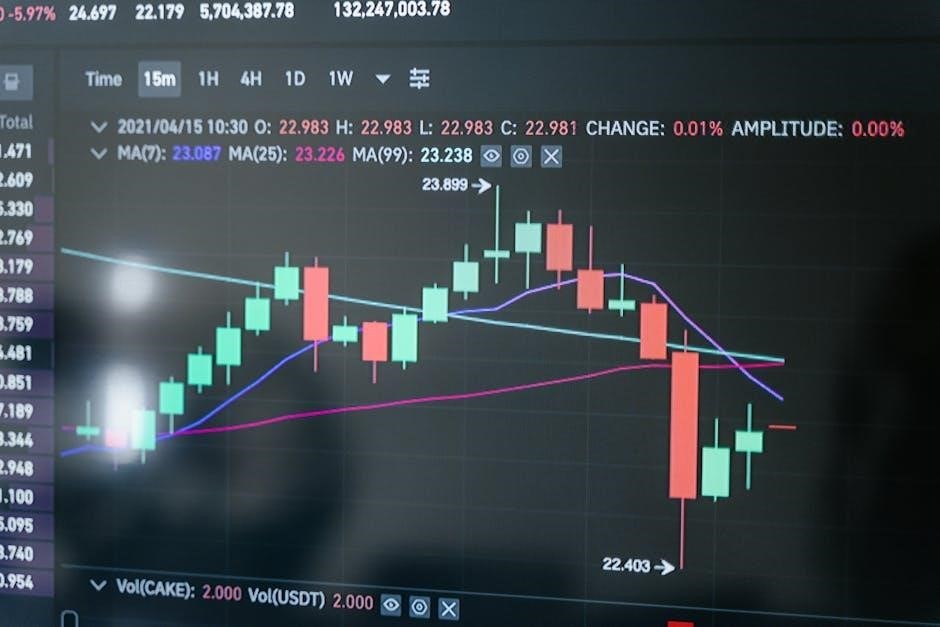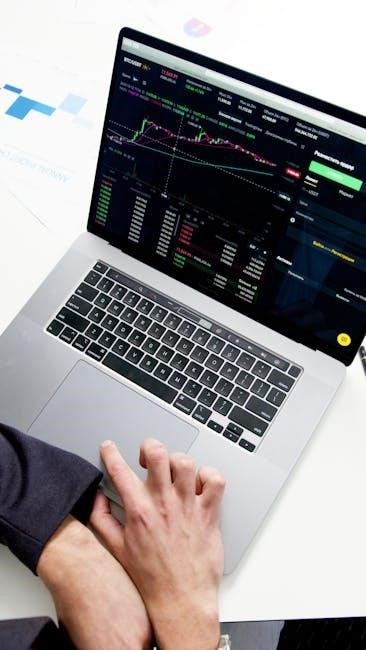Welcome to the comprehensive guide on Centigrade to Fahrenheit charts. This resource provides a detailed overview of temperature conversion, focusing on the practical use of PDF charts for quick and accurate conversions. Perfect for everyday applications, cooking, and scientific purposes, these charts simplify the process of switching between Celsius and Fahrenheit scales, ensuring precision and efficiency in various fields.

What is the Centigrade to Fahrenheit Chart?
A Centigrade to Fahrenheit chart is a visual or tabular tool designed to simplify temperature conversions between the Celsius (°C) and Fahrenheit (°F) scales. It typically includes a range of temperatures, often from -40°C to 225°C, with corresponding Fahrenheit values. These charts are widely used for quick reference, eliminating the need for manual calculations. They are particularly useful for individuals who need to switch between the two scales frequently, such as in cooking, scientific research, or engineering. The chart can be presented in various formats, including tables, graphs, or PDF documents, making it easy to print or access digitally. Many charts also include formulas and step-by-step guides to help users understand the conversion process. By providing a clear and organized layout, a Centigrade to Fahrenheit chart ensures accuracy and efficiency in temperature conversions.
Importance of Temperature Conversion Charts
Temperature conversion charts are essential tools for accurately converting temperatures between Celsius and Fahrenheit scales. They provide a standardized reference, ensuring consistency in measurements across various industries and applications. These charts are particularly valuable in fields such as cooking, baking, engineering, and meteorology, where precise temperature control is critical. By offering a quick and reliable way to convert temperatures, they eliminate the risk of errors that can arise from manual calculations. Additionally, conversion charts are widely used in educational settings to teach students about temperature scales and their practical applications. For individuals and professionals alike, these charts serve as a convenient and accessible resource, saving time and enhancing productivity. Their importance is further emphasized in international contexts, where both Celsius and Fahrenheit scales are used, making seamless conversion a necessity.
Key Features of a Centigrade to Fahrenheit Chart PDF
A Centigrade to Fahrenheit Chart PDF is a versatile and user-friendly resource designed to facilitate quick and accurate temperature conversions. One of its key features is the ability to cover a wide range of temperatures, often spanning from -40°C to 225°C, with incremental steps for precise conversions. The chart typically includes columns for both Celsius and Fahrenheit values, making it easy to cross-reference temperatures. Many PDF charts are formatted in a clean, readable layout, ensuring that users can quickly locate and interpret the data. Some versions also include formulas and conversion guides to help users understand the mathematical process behind the conversions. Additionally, the PDF format allows for easy printing and sharing, making it a practical tool for both personal and professional use. These charts are often free to download and can be accessed from various online sources, providing a convenient solution for anyone needing to convert temperatures frequently.
Benefits of Using a Printable Temperature Conversion Chart
Using a printable temperature conversion chart offers numerous benefits for individuals needing to convert Celsius to Fahrenheit frequently. One of the primary advantages is the ability to perform quick and accurate conversions without relying on digital tools, making it ideal for environments where technology is unavailable or impractical. The chart provides a clear, visual representation of temperature equivalents, allowing users to locate and interpret data effortlessly. Its portability ensures that it can be used in various settings, such as laboratories, classrooms, or kitchens. Additionally, printable charts are often designed with a user-friendly layout, featuring incremental temperature steps for precise conversions. They are also easily shareable and can be distributed among team members or students for collaborative use. Furthermore, having a physical copy eliminates the need for internet access, making it a reliable resource in all situations. This practical tool is perfect for everyday applications, scientific research, and educational purposes.

Understanding the Conversion Process
The conversion process from Celsius to Fahrenheit involves a mathematical formula and a straightforward approach. This section explains the fundamental principles and methods behind temperature conversion, ensuring clarity and precision for all users.
The Formula for Converting Celsius to Fahrenheit
The formula to convert temperatures from Celsius (°C) to Fahrenheit (°F) is a fundamental tool for accurate conversions. The formula is expressed as:
F = (9/5 × C) + 32
Here, C represents the temperature in Celsius, and F is the equivalent temperature in Fahrenheit. To use this formula, simply multiply the Celsius value by 9/5 and then add 32 to the result. This calculation ensures a precise conversion between the two scales. For example, to convert 20°C to Fahrenheit, you would calculate F = (9/5 × 20) + 32 = 36 + 32 = 68°F. Understanding this formula is essential for situations where a conversion chart is not available, providing flexibility and accuracy in various applications. Mastering this formula is a key skill for anyone working with temperature conversions.
Step-by-Step Guide to Using the Conversion Chart
Using a Centigrade to Fahrenheit conversion chart is straightforward, but following a structured approach ensures accuracy. First, locate the Celsius temperature you wish to convert. This is typically listed in a column or row on the chart. Next, identify the corresponding Fahrenheit value aligned with the Celsius temperature, ensuring they are paired correctly. For example, if you find 20°C on the chart, the adjacent value will be its Fahrenheit equivalent, 68°F. It’s important to verify the scale increments, as charts may vary (e.g., 1°, 5°, or 10° steps). Once you’ve matched the temperatures, read the Fahrenheit value directly. This method works for both ascending and descending temperature ranges. For precise conversions, especially in critical applications like cooking or engineering, double-check the values against the formula F = (9/5 × C) + 32 if necessary. This step-by-step process ensures quick and reliable temperature conversions using the chart.
Key Temperature Points to Remember
Understanding key temperature points is essential for accurate conversions between Centigrade and Fahrenheit scales. One of the most critical points is the freezing temperature of water, which is 0°C in Centigrade and 32°F in Fahrenheit. Similarly, the boiling point of water is 100°C and 212°F, serving as a primary reference. Another important point is -40°C, which equals -40°F, a unique convergence of both scales. These benchmarks are vital for quick conversions and verifying accuracy. Additionally, everyday temperatures like 20°C (68°F) and 37°C (98.6°F) are commonly referenced in cooking and health contexts. Memorizing these key points simplifies the use of conversion charts and formulas, ensuring efficiency in practical applications; By focusing on these critical temperatures, users can navigate the chart with confidence and apply the conversions effectively in real-world scenarios. These key points are also highlighted in most printable PDF charts for easy identification and reference.
Avoiding Common Errors in Conversion
When using a Centigrade to Fahrenheit chart, it’s crucial to avoid common errors that can lead to inaccurate conversions. One of the most frequent mistakes is reversing the formula steps, such as forgetting to add 32 after multiplying by 9/5. Another error is misaligning temperatures in the chart, leading to mismatched values. Users should also be cautious with decimal points, as small rounding differences can cause significant discrepancies in precise measurements. Additionally, confusion between Celsius and Fahrenheit scales when interpreting the chart can result in incorrect conversions. To minimize errors, always cross-verify calculations with the formula or a digital converter. Pay attention to temperature ranges, as some charts may skip increments, leading to interpolation errors. By carefully following the chart’s structure and double-checking conversions, users can ensure accuracy and reliability in their results. Printable PDF charts often include guides to help avoid these pitfalls, making conversions more straightforward and error-free.

Types of Centigrade to Fahrenheit Charts
Centigrade to Fahrenheit charts come in various formats, including basic tables, detailed incremental charts, and interactive digital versions. They may also include conversion formulas for quick reference, catering to different user needs.

Basic Temperature Conversion Tables
Basic temperature conversion tables provide a straightforward way to convert Celsius to Fahrenheit. These tables typically list Celsius temperatures alongside their Fahrenheit equivalents, offering a quick reference for common values. They are often formatted in a simple, two-column layout, making it easy to locate a specific temperature and find its conversion. Many basic tables cover a range from -40°C to 50°C, with each degree increment included for precision. For example, 0°C is shown as 32°F, while 100°C converts to 212°F. These tables are widely available in PDF formats, allowing users to print them for easy access. They are ideal for everyday use, cooking, or educational purposes, serving as a reliable tool for anyone needing to switch between the two scales. The simplicity of these tables ensures that users can quickly find the information they need without unnecessary complexity.
Detailed Charts with Incremental Degrees
Detailed Centigrade to Fahrenheit charts with incremental degrees offer precise temperature conversions, ideal for applications requiring exact measurements. These charts typically cover a wide range, from -40°C to 225°C, with increments as small as 1 degree, ensuring granularity for accurate conversions. For instance, a chart might list every degree between 0°C and 100°C, making it invaluable for scientific research or engineering. Some charts may use 5-degree increments for broader applications, such as cooking or industrial monitoring. Available in PDF formats, these charts are easily printable and serve as essential tools in laboratories and industrial settings where temperature monitoring over a wide range is crucial. Their detailed nature allows users to quickly reference specific conversions, enhancing efficiency and precision in various fields. These charts are particularly beneficial for applications where exact temperature control is necessary, ensuring reliability and ease of use.
Charts with Formulas and Conversion Guides
Charts with formulas and conversion guides are essential for understanding the mathematical relationship between Centigrade and Fahrenheit. These resources often include the formula F = (C × 9/5) + 32, which is fundamental for manual conversions. By providing both the formula and a table, users can cross-reference values to ensure accuracy. Many PDF charts also offer step-by-step conversion guides, making them ideal for educational purposes or for those learning how to convert temperatures. Some charts even include reverse formulas, allowing users to convert Fahrenheit to Celsius using C = (F ⏤ 32) × 5/9. These comprehensive tools are particularly useful for students, professionals, and anyone needing to understand the science behind temperature conversion. With both formulas and tables in one place, these charts serve as a one-stop solution for precise and reliable temperature conversions, enhancing learning and practical applications. They are widely available in printable PDF formats, making them accessible for various settings.
Interactive and Digital Conversion Charts
Interactive and digital conversion charts are modern tools designed for quick and precise temperature conversions. These charts often feature user-friendly interfaces that allow real-time input, enabling users to enter a temperature in Celsius and instantly receive the equivalent in Fahrenheit, or vice versa. Many digital charts are web-based or available as mobile apps, making them accessible from any device. Some advanced versions include features like decimal precision, allowing for more accurate conversions, especially in scientific or engineering contexts. These tools are particularly useful for professionals who need frequent temperature conversions, such as meteorologists or chefs. Additionally, interactive charts often include built-in formulas, ensuring that users understand the mathematical process behind the conversion. Unlike static PDF charts, digital versions can be easily updated and customized, offering a dynamic and efficient way to handle temperature conversions in various applications. They are ideal for those who prefer a more engaging and instantaneous approach to temperature conversion.

How to Read and Use the Chart
To effectively use a Centigrade to Fahrenheit chart, locate the desired temperature in the Celsius column and find its corresponding Fahrenheit value in the adjacent column. This method ensures quick and accurate conversions for practical applications, eliminating the need for complex calculations and enhancing efficiency in various tasks.
Locating Temperatures in the Chart
To locate temperatures in a Centigrade to Fahrenheit chart, start by identifying the scale that aligns with your needs. Most charts feature two columns: one for Celsius and one for Fahrenheit. Begin by finding the Celsius temperature you wish to convert in the left column. Once located, follow the row across to the corresponding Fahrenheit value. For example, if you’re looking for 20°C, trace the row to find its equivalent, 68°F. Charts often include incremental degrees, making it easy to find precise values. Some charts may also highlight key temperatures, such as the freezing point of water (0°C/32°F) or boiling point (100°C/212°F), to aid quick reference. Ensure the chart covers the range you need, as some extend from -40°C to 225°C. By using the chart’s organized structure, you can efficiently find any temperature conversion without confusion.
Understanding the Equivalent Values
Understanding equivalent values in a Centigrade to Fahrenheit chart is crucial for accurate temperature conversion. Once you locate a temperature in the chart, the corresponding value in the adjacent column represents its equivalent in the other scale. For instance, if you find 50°C in the Celsius column, the chart will show its Fahrenheit equivalent, 122°F, directly beside it. These paired values ensure a straightforward conversion process. The chart often includes key reference points, such as the freezing point of water (0°C/32°F) and boiling point (100°C/212°F), to help users verify their conversions. By studying these equivalent values, you can gain a better understanding of how temperatures relate across both scales. This knowledge is particularly useful for practical applications like cooking, where precise temperature control is essential. Always cross-check your readings to ensure accuracy, especially when working with critical temperature ranges.
Converting Celsius to Fahrenheit in Real-Time
Converting Celsius to Fahrenheit in real-time is made effortless with a Centigrade to Fahrenheit chart PDF. These charts provide a quick reference guide, allowing users to instantly find equivalent temperatures without performing complex calculations. For example, if you need to convert 30°C to Fahrenheit, you can simply locate 30°C in the chart and find its corresponding Fahrenheit value, 86°F, alongside it. This real-time conversion is particularly useful in dynamic situations, such as cooking, where precise temperature control is critical. The chart’s organized format ensures that users can swiftly identify the desired temperature and its equivalent, saving time and reducing the risk of errors. Whether you’re adjusting recipes or monitoring environmental conditions, a printable conversion chart becomes an indispensable tool for accurate and efficient real-time conversions. Its simplicity makes it accessible to both professionals and individuals, ensuring seamless temperature conversions across various applications.
Interpreting the Data for Practical Applications
Interpreting the data from a Centigrade to Fahrenheit chart PDF is essential for practical applications across various fields. The chart provides a clear and organized way to understand temperature equivalences, enabling users to apply the data effectively. For instance, in cooking, the chart helps adjust recipes by converting oven temperatures, ensuring dishes are baked or roasted at the correct heat. In engineering and science, accurate temperature interpretations are critical for material specifications and experiments. The chart also aids in weather forecasting, where converting temperatures for public communication is vital. By interpreting the data, users can seamlessly transition between Celsius and Fahrenheit, ensuring precision in their work. This tool is particularly useful for professionals and hobbyists alike, offering a reliable reference for real-world applications. Its user-friendly format makes it easy to interpret and apply the data in diverse scenarios, from everyday tasks to complex projects.

Key Temperature Ranges and Conversions
Centigrade to Fahrenheit charts PDFs typically cover essential temperature ranges, from freezing to extreme heat, providing clear conversions for practical use in cooking, science, and everyday applications.
-40°C to 0°C: Freezing Point Conversions
The range from -40°C to 0°C is critical for understanding freezing point conversions between Celsius and Fahrenheit. This range is often used in scientific and everyday applications, such as meteorology and cooking, where precise temperature control is essential. At -40°C, the temperature equals -40°F, a key point where both scales align. As temperatures rise, 0°C corresponds to 32°F, marking the freezing point of water. This range is vital for tasks like monitoring frost levels, defrosting, or preparing frozen foods.
- -50°C = -58°F (extremely cold conditions)
- -40°C = -40°F (alignment of both scales)
- -10°C = 14°F (freezing to above freezing transition)
Understanding these conversions ensures accuracy in fields requiring temperature precision, such as engineering and food safety.
0°C to 50°C: Everyday Temperature Conversions
The range from 0°C to 50°C is one of the most frequently used temperature ranges in daily life, covering everything from freezing to moderately hot conditions. This range is essential for cooking, weather forecasting, and health-related applications. At 0°C (32°F), water freezes, while at 50°C (122°F), temperatures are hot enough to require caution.
- 0°C = 32°F (freezing point of water)
- 20°C = 68°F (room temperature)
- 37°C = 98.6°F (average human body temperature)
- 50°C = 122°F (hot water or warm environments)
This range is particularly useful for tasks like baking, where precise temperature control is critical, and for understanding weather conditions, such as frost formation or heatwaves. Using a printable Centigrade to Fahrenheit chart for this range ensures quick and accurate conversions, making it a valuable tool for both personal and professional use.
50°C to 100°C: High-Temperature Conversions
The range from 50°C to 100°C represents high temperatures commonly encountered in industrial processes, cooking, and extreme weather conditions. This range is crucial for understanding boiling points, heat management, and safety protocols. At 100°C (212°F), water reaches its boiling point at sea level, while 50°C (122°F) is often used in industrial heating applications.
- 50°C = 122°F (common in industrial heating)
- 75°C = 167°F (typical for sterilization processes)
- 90°C = 194°F (used in high-temperature cooking)
- 100°C = 212°F (boiling point of water)

This range is vital for professionals in manufacturing, culinary arts, and climate monitoring. A printable Centigrade to Fahrenheit chart for this range is indispensable for precise temperature management, ensuring efficiency and safety in operations requiring high heat.
100°C to 225°C: Extreme Heat Conversions

The range from 100°C to 225°C represents extreme temperatures often encountered in industrial, laboratory, and high-heat applications. This range is critical for processes like metal melting, advanced manufacturing, and scientific research. At 100°C (212°F), water boils, while 225°C (437°F) is commonly used in industrial furnaces.
- 100°C = 212°F (boiling point of water)
- 150°C = 302°F (used in metalworking)
- 200°C = 392°F (common in industrial ovens)
- 225°C = 437°F (high-temperature industrial applications)
This range is essential for professionals in manufacturing, metallurgy, and advanced thermal processing. A printable Centigrade to Fahrenheit chart for this range ensures precise monitoring and control in environments requiring extreme heat management. It is a vital tool for maintaining operational safety and efficiency in high-temperature settings.

Practical Applications
Temperature conversion charts are essential for cooking, engineering, and meteorology, offering quick and accurate data for professional and everyday tasks, ensuring efficiency and precision in various fields and formats.
Using the Chart for Cooking and Baking
A Centigrade to Fahrenheit chart is indispensable in cooking and baking, where precise temperature control is crucial. Whether converting oven temperatures for recipes or ensuring ingredients reach the correct heat, the chart provides quick references. For example, 180°C (ideal for baking) equals 350°F, while 100°C (boiling point) is 212°F. This tool is especially handy for recipes that list temperatures in one scale but require conversion for equipment calibrated in the other. Printable PDF charts are often used in kitchens for easy access, reducing errors and saving time. By ensuring accurate conversions, home cooks and professional chefs can achieve consistent results, making it an essential resource for any culinary task.
Applications in Science and Engineering
In scientific and engineering fields, precise temperature measurement is critical, making Centigrade to Fahrenheit charts essential tools. These charts enable seamless conversions between the two scales, ensuring data consistency across projects. For instance, in meteorology, where temperature data is often reported in both scales, the chart facilitates accurate weather forecasting and climate analysis. In engineering, it aids in designing systems that operate across different regions, where equipment may use varying temperature scales. Laboratories also rely on these charts for calibrating instruments and interpreting experimental results. Additionally, in industrial settings, such as manufacturing and quality control, accurate temperature conversions are vital for maintaining product safety and process efficiency. The chart’s precision ensures that critical thresholds, like material melting points or operating ranges, are accurately monitored and applied. This makes it an indispensable resource for professionals requiring reliable temperature data in their work.
Weather Forecasting and Meteorology
In weather forecasting and meteorology, accurate temperature conversions are vital for precise predictions and global data consistency. Meteorologists frequently use Centigrade to Fahrenheit charts to convert data, especially when collaborating across regions with different temperature scales. For instance, temperatures collected in Celsius from international stations can be quickly converted to Fahrenheit for US audiences. These charts are particularly useful for real-time weather events, ensuring that temperature readings, such as extreme heat or cold fronts, are accurately communicated. Additionally, historical climate data often requires conversion to maintain uniformity in global records. The availability of detailed PDF charts with incremental scales enhances the precision of these conversions, making them indispensable tools for meteorologists. By providing a reliable and efficient method of temperature conversion, these charts play a crucial role in ensuring the accuracy and effectiveness of weather forecasting and meteorological research worldwide.
